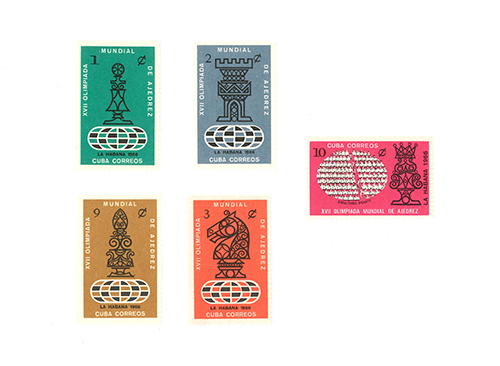by Tara Meyer
Today, the term “Mid-century modern” evokes a certain enthusiastic remembrance for the past. Currently, the World Chess Hall of Fame’s exhibition, Global Moves: Americans in Chess Olympiads, inspires a similar reaction in its viewers. Created as an ode to olympiad chess history, Global Moves seeks to discuss the experiences of American chess players through the exhibition of artifacts and objects from the chess olympiads of the past century, some of which include mid-century designs.
One set of artifacts on display that have an interesting inspiration for their designs are the Five Stamps from the 1966 Havana, Cuba, Chess Olympiad. On view in the 1960s Olympiad vitrine, these chess stamps feature familiar stylistic attributes from the middle of the 20th century, including curvilinear lines with minimal text and vibrant color. Consisting of small, equally-sized pieces of paper and lithographic printed ink, these five commemorative Cuban stamps contain images of a pink queen, a gold bishop, an orange knight, a light blue rook, and a green pawn. Not seen here, however, is the teal-blue stamp with the highest denomination showing the king. The designs and bold colors are distinguishably mid-century and are reminiscent of the colorful culture and architecture found in Cuba, something that undoubtedly drew the attention of the spectators in 1966.

Five Stamps from the 1966 Havana, Cuba, Chess Olympiad
1966
1 ¾ x 1 1⁄8 in.
Lithograph printed stamps
Collection of the World Chess Hall of Fame
Notable not only for their designs, these stamps contain an interesting historical significance. They were created in 1966 for the 17th chess olympiad, which had Fidel Castro as the Head of the Organizing Committee and is currently the first and only time that Cuba has hosted a chess olympiad. The Soviet Union won their eighth consecutive gold medal while the United States, an active participant in chess olympiads in the 60s, placed second with the help of Bobby Fischer. Accompanying the five stamps from the Havana olympiad is one of the tournament’s chess tables. The highlight of Global Moves, the newly conserved chess table and chairs were designed specifically for comfort and functionality of playing chess. Along with this chess table, the artifacts and other memorabilia on display in Global Moves makes it clear to see how important the exhibition, restoration, and research of chess artifacts is to chess history as well as the current chess design and exhibit execution at the World Chess Hall of Fame.

